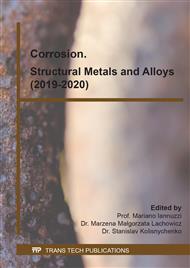[1]
T.R. Allen, R.J.M. Konings, A.T. Motta, Corrosion of zirconium alloys, Compr. Nucl. Mater. 24 (2012) 49-68.
Google Scholar
[2]
A. Nechaev, Corrosion of zirconium alloys in nuclear power plants, IAEA-TECDOC, IAEA (1993).
Google Scholar
[3]
Y. H. Jeong, J. H. Baek, S. J. Kim, H. G. Kim, H. Ruhmann, Corrosion characteristics and oxide microstructures of zircaloy-4 in aqueous alkali hydroxide solutions. J. Nucl. Mater. 270 (1999) 322-333.
DOI: 10.1016/s0022-3115(99)00008-2
Google Scholar
[4]
H. Schubert, F. Frey, Stability of Y-TZP during hydrothermal treatment: neutron experiments and stability considerations, J. Eur. Ceram. Soc. 25 (2005) 1597-1602.
DOI: 10.1016/j.jeurceramsoc.2004.03.025
Google Scholar
[5]
B. Cox, Some thoughts on the mechanisms of in-reactor corrosion of zirconium alloys, J. Nucl. Mater. 336 (2005) 331-368.
DOI: 10.1016/j.jnucmat.2004.09.029
Google Scholar
[6]
B. Cox, M. Ungurelu, Y.M. Wong, C. Wu, in: E.R. Bradley, G.P. Sabol (Eds.), Zirconium in the Nuclear Industry: Eleventh International Symposium, ASTM STP, 1295, American Society for Testing and Materials, Philadelphia, 1996, p.114.
DOI: 10.1520/stp16170s
Google Scholar
[7]
A. T. Motta, A. Couet, R. J. Comstock, Corrosion of zirconium alloys used for nuclear fuel cladding, Annu. Rev. Mater. Res. 45 (2015) 311-343.
DOI: 10.1146/annurev-matsci-070214-020951
Google Scholar
[8]
M. Preuss, P. Frankel, S. Lozano-Perez, D. Hudson, E. Polatidis, N. Ni, et al, Studies regarding corrosion mechanisms in zirconium alloys, J. ASTM Int. 8 (2011) 1-23.
DOI: 10.1520/jai103246
Google Scholar
[9]
E. Polatidis, P. Frankel, J. Wei, M. Klaus, R. J. Comstock, A. Ambard, et al, Residual stresses and tetragonal phase fraction characterization of corrosion tested zircaloy-4 using energy dispersive synchrotron x-ray diffraction, J. Nucl. Mater. 432 (2013) 102-112.
DOI: 10.1016/j.jnucmat.2012.07.025
Google Scholar
[10]
I. Idarraga, C. Duriez, M. Mermoux, A. Crisci, J. P. Mardon, Potentialities of Raman imaging for the analysis of oxide scales formed on Zircaloy-4 and M5 in air at high temperature, Oxid. Met. 79 (2013) 289-302.
DOI: 10.1007/s11085-012-9331-5
Google Scholar
[11]
P. Platt, S. Wedge, P. Frankel, M. Gass, R. Howells, M. Preuss, A study into the impact of interface roughness development on mechanical degradation of oxides formed on zirconium alloys, J. Nucl. Mater. 459 (2015) 166-174.
DOI: 10.1016/j.jnucmat.2015.01.028
Google Scholar
[12]
L. Kurpaska, J. Favergeon, et al. Zirconia layer formed by high temperature oxidation of pure zirconium: stress generated at the zirconium/zirconia interface, Oxid. Met. 79 (2013) 261-277.
DOI: 10.1007/s11085-012-9348-9
Google Scholar
[13]
L. Kurpaska, I. Jozwik, J. Jagielski, Study of sub-oxide phases at the metal-oxide interface in oxidized pure zirconium and zr-1.0% nb alloy by using sem/fib/ebsd and eds techniques, J. Nucl. Mater. 476 (2016) 56-62.
DOI: 10.1016/j.jnucmat.2016.04.038
Google Scholar
[14]
W. Qin, C. Nam, H. L. Li, J. A. Szpunar, Tetragonal phase stability in zro film formed on zirconium alloys and its effects on corrosion resistance, Acta Mater. 55 (2007) 1695-1701.
DOI: 10.1016/j.actamat.2006.10.030
Google Scholar
[15]
G. Xin, Property degradation of tetragonal zirconia induced by low-temperature defect reaction with water molecules, Chem. Mater. 16 (2004) 3988-3994.
DOI: 10.1021/cm040167h
Google Scholar
[16]
J. Wei, P. Frankel, E. Polatidis, M. Blat, A. Ambard, R. J. Comstock, et al, Acta Mater. 61 (2013) 4200-4214.
Google Scholar
[17]
G. Sundell, M. Thuvander, H. O. Andrén, Barrier oxide chemistry and hydrogen pick-up mechanisms in zirconium alloys, Corros. Sci. 102 (2016) 490-502.
DOI: 10.1016/j.corsci.2015.11.002
Google Scholar
[18]
H. Hulme, F. Baxter, R. P. Babu, M. A. Denecke, M. Gass, A. Steuwer, et al, Corros. Sci. 105 (2016) 202-208.
Google Scholar
[19]
J. H. Baek, Y. H. Jeong, I. S. Kim, J. Nucl. Mater. 280 (2000) 235-245.
Google Scholar
[20]
H. G. Kim, J. Y. Park, Y. H. Jeong, Ex-reactor corrosion and oxide characteristics of Zr–Nb–Fe alloys with the Nb/Fe ratio, J. Nucl. Mater. 345 (2005) 1-10.
DOI: 10.1016/j.jnucmat.2005.04.061
Google Scholar



